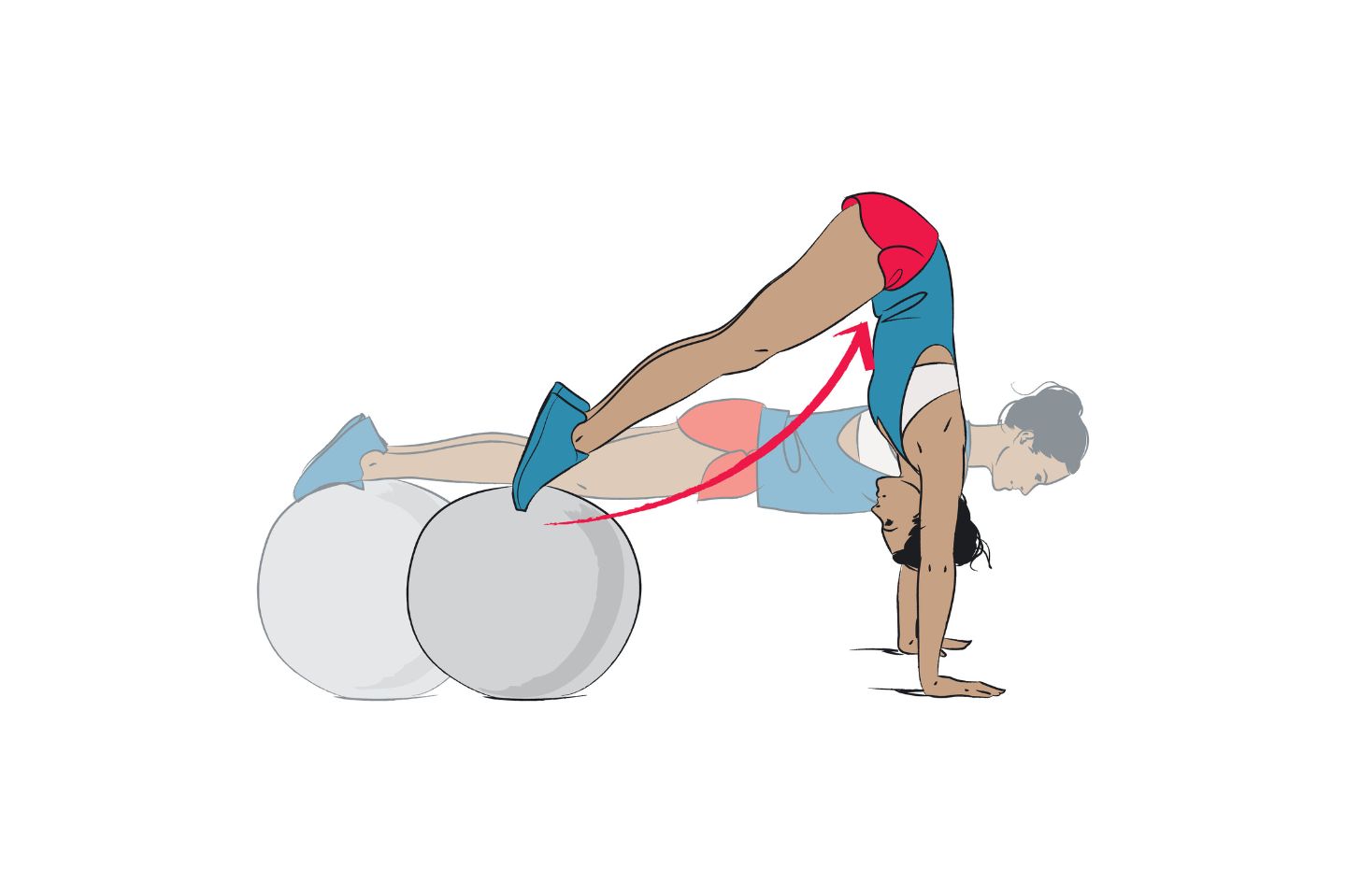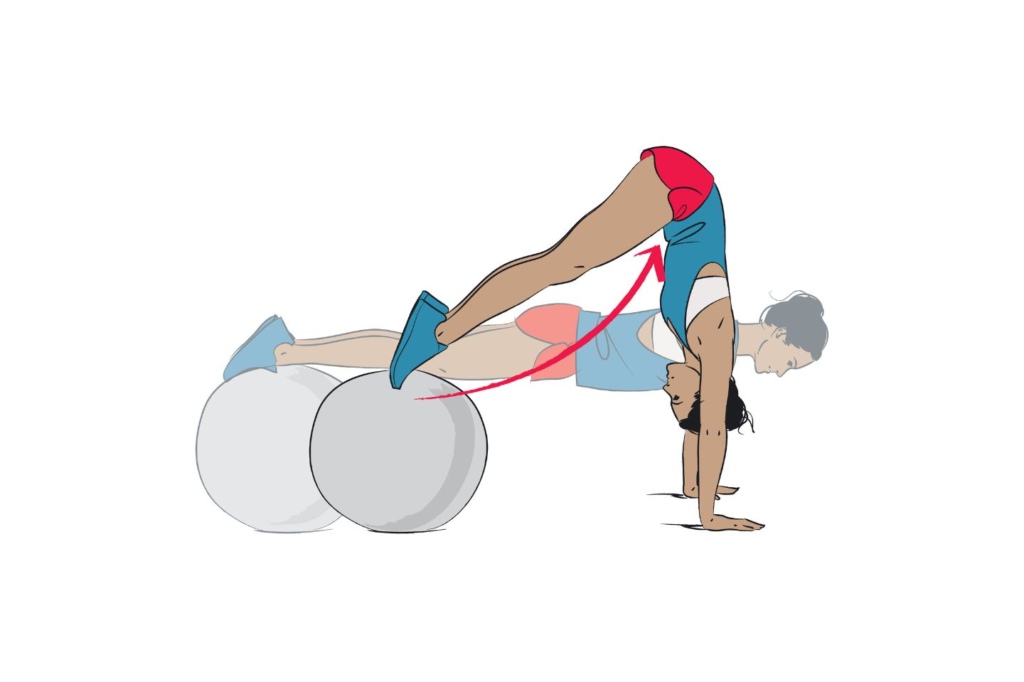
With just six basic moves and an exercise ball, you can strengthen your core, decrease back pain, and develop functional stability that translates to all areas of life.
Training with a Swiss ball can have many benefits. For instance, a study by Chung from 2013 found that consistent exercise with a stability ball led to pain relief for patients with low back pain, among other desirable outcomes.
Best of all, you don’t need to spend hours in the gym performing hundreds of exercises to reap the benefits of Swiss ball training. With just six simple movements, as demonstrated by Rhiannon Bailey in this video, you too can begin to build a solid, functional core.
Of course, some of these moves are advanced and require significant baseline strength. If you find that you are unable to complete this exercise routine with good form, be sure to modify the program as needed.
But before we dive into the workout itself, let’s discuss some of the specific features of the stability ball that make it such a great choice as an exercise implement.
Benefits of a Stability Ball

As was mentioned in the introduction, stability ball training provides a host of benefits. Specifically, stability balls are affordable, durable, and able to be used for a variety of health/fitness goals.
Selecting the right exercise ball is less complicated than it may seem, despite all of the options out there. In general, the bigger the ball, the easier it will be to use for most movements. This is because you have more room for error on a larger ball, which allows you more time for corrections before you slip off.
Also, it’s a good idea to use the ball near a supportive surface where you can support yourself when needed.
Cost of Stability Balls
Stability balls can range widely in size and quality, which can affect the price. However, you’d be hard-pressed to find a ball that costs more than 25 dollars. At this price point, it’s easy for many gyms to keep these items in stock. Further, it’s also easy for anyone to add a Swiss ball to their home gym.
Durability
Exercise balls are often made of very strong material, preventing them from being punctured during workouts. This means that the only maintenance required for most balls is keeping them filled with air. Stability balls can really take a pounding: from tossing them, bouncing on them, and even standing on them; these tools last a long time.
Health and Fitness Goals
Back pain is a pervasive issue in society. In a study from 2009, Freburger highlights the dramatic rise of low back pain over the past few decades. For this reason, it’s important to find effective and widely available treatments for this condition. Exercising with a Swiss ball can go a long way toward preventing and treating low back pain.
Further, Swiss ball training can help athletes and high-level exercisers reach new heights. By completing advanced movements on a stability ball, athletes can significantly improve their performance and decrease their risk of injury.
Six-Move Exercise Ball Workout
For this workout, I recommend performing each move in succession, performing 10-12 reps for every exercise. So, once you complete 10-12 reps of the first move, immediately transition to the next exercise, and so forth until you finish all of the exercises.
I recommend starting with 3 complete circuits of each exercise, then increasing the number of circuits from there as you get stronger.
1. Knees to Chest
This exercise emphasizes the shoulders, chest, triceps, and the “six-pack” ab muscles. Make sure you have good plank form and balance when completing the knees-to-chest exercise.
How to Perform
- Start in a pushup position, with your hands on the ground and your shins on the ball.
- Keeping your back flat, roll the ball toward your hands by tucking your knees to your chest.
- Roll the ball back to the starting position to complete the rep.
2. Pike Ups
Pike-ups are just like knees to chest, but they are a bit more difficult and require a bit more balance/hamstring flexibility.
How to Perform
- Start in a pushup position, with your hands on the ground and your toes on the ball.
- Roll the ball up toward your hands, moving into a “pike” position.
- Roll the ball back to the starting position to complete the rep.
3. Lateral Toe Taps
This move incorporates the oblique muscles, which are a major part of the core.
How to Perform
- Start in a pushup position, with shins on the ball and hands on the ground.
- Keeping your back flat, tap your right toes to the ground on the right side of the ball.
- Return your right leg to the starting position and repeat on the left side.
- Return both legs to the ball to complete one rep.
4. Pot Stirrers
Pot stirrers require a significant amount of core and upper body stability. I recommend if you’re trying this move for the first time, keeping your feet spread wide for increased balance.
How to Perform
- Start with your forearms on the ball and your feet on the ground, in plank position.
- Push your elbows forward, in a clockwise motion, and make a full circle before returning to the starting position to complete one rep.
- Alternate between clockwise and counterclockwise motion on every rep.
5. Rotational Crunches on the Ball
Crunches are one of the most fundamental core exercises in existence. By performing them on a ball, you can get much more bang for your buck.
How to Perform
- Lie on the ball on your back.
- Perform a crunch and reach your left hand toward your right knee.
- Return to the starting position and complete on the other side.
- Return to the starting position to complete one rep.
6. V-Sit Ball Pass
Last but not least, we have the V-sit ball pass. While this is perhaps the safest move on the list, it’s certainly not the easiest.
How to Perform
- Lie on your back on the floor.
- Keeping your legs straight, hold the ball between your feet.
- Extend your arms up over your head.
- Perform a situp and bring the ball up to your hands as you meet your legs and hands in the middle of the motion.
- Pass the ball to your hands and bring it back over your head as you return your straight legs to the floor.
- Perform the moment again and pass the ball back to your legs to finish the rep.
Conclusion
Swiss ball training is a great choice for nearly everyone. These exercise tools can help with a variety of goals and they provide numerous benefits to people of all backgrounds and experience levels.
The workout described above should be considered a moderate to advanced program. Therefore, if you are new to the gym, be sure to take your time and learn the basics before jumping into this workout fully.
Works Cited
- Chung S, Lee J, Yoon J. Effects of stabilization exercise using a ball on multifidus cross-sectional area in patients with chronic low back pain. J Sports Sci Med. 2013 Sep 1;12(3):533-41. PMID: 24149162; PMCID: PMC3772599.
- Freburger JK, Holmes GM, Agans RP, Jackman AM, Darter JD, Wallace AS, Castel LD, Kalsbeek WD, Carey TS. The rising prevalence of chronic low back pain. Arch Intern Med. 2009 Feb 9;169(3):251-8. doi: 10.1001/archinternmed.2008.543. PMID: 19204216; PMCID: PMC4339077.


